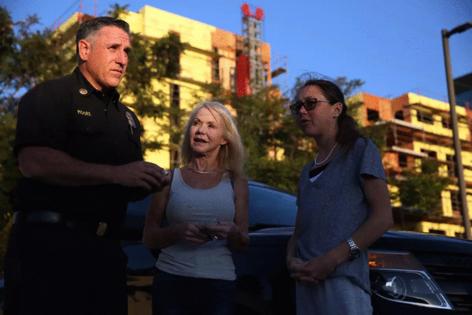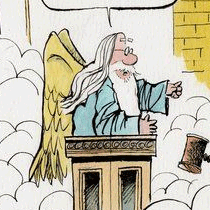LAFD insider named chief amid lingering questions about Palisades fire
Published in News & Features
LOS ANGELES — As Jaime Moore prepares to take the helm of the Los Angeles Fire Department, he said he plans to commission an outside investigation into missteps by fire officials during the mop-up of a small brush fire that reignited days later into the destructive Palisades fire.
Mayor Karen Bass had requested a probe late last month in response to reporting by the Los Angeles Times that firefighters were ordered to roll up their hoses and leave the burn area, even though they had complained that the ground was still smoldering.
Moore — a 30-year department veteran whose appointment was confirmed Friday by the Los Angeles City Council — said the reports have generated “understandable mistrust” in the agency.
The Times found that at least one chief assigned to LAFD’s risk management section knew about the complaints for months, but that the department kept that information hidden despite Palisades fire victims pleading for answers about whether more could have been done to protect their community.
On Wednesday, Moore told the council’s public safety committee that bringing in an outside organization to investigate the LAFD’s handling of the Jan. 1 Lachman fire would be one of his first moves as chief.
“Transparency and accountability are vital to ensure that we learn from every incident and is essential if we are to restore confidence in our Fire Department,” Moore said. “As fire chief, I will focus on rebuilding trust, not just with the public, but within the LAFD itself.”
Federal investigators say the Lachman fire was deliberately set on New Years’ Day and burned underground in a canyon root system until it was rekindled by high winds on Jan. 7. LAFD officials have said they believed the earlier fire was fully extinguished.
Moore said one of his top priorities is raising morale in a department that has come under heavy criticism for its handling of the worst wildfire in city history, which killed 12 people and destroyed thousands of homes.
In the days after the Jan. 7 Palisades fire, The Times reported that LAFD decided not to pre-deploy any engines or firefighters to the Palisades — as they had done in the past — despite being warned that some of the most dangerous winds in recent years were headed for the region.
An LAFD after-action report released last month described fire officials’ chaotic response, which included major staffing and communication issues.
Moore — who has the backing of the United Firefighters of Los Angeles City, the union that represents firefighters — said his other priorities include better preparation for major disasters, with a focus on pre-deployment and staffing, as well as for the 2026 World Cup and the 2028 Olympics.
“I’ve got skin in the game,” he said, adding that his son is an LAFD firefighter. “We need to address the amount of calls they’re going on, and make sure that they’re going on the right calls with the right resources, and if that means us having to change our department model, so be it. I have the courage to do that.”
He also said he wants to expand the LAFD’s technological capabilities and better deploy the equipment it already has, like the thermal imaging cameras and heat-detecting drones that officials did not deploy during the Lachman fire mop-up.
“We are now requiring them to be used, and we’re not picking up any type of hose until we know that we’ve been able to identify through the use of the drone, thermal imaging cameras to ensure that those surface hot spots are all taken care of,” he said.
“I wish it didn’t take this for us to have to learn the lesson about using the tools we already have,” Council member Traci Park replied.
Park grilled Moore on reporting by the Times that firefighters warned a battalion chief about the Lachman fire not being fully extinguished.
“We know now that our own firefighters on the ground were offering warnings that it was still too hot, that it was still too smoldering,” Park said. “For Palisades residents and Angelenos across the city who have questions and concerns, what would you say to them at this point?”
Moore referred back to independent investigation he plans to launch.
“I want to know why it happened, how it happened, and take the necessary steps to ensure that never happens again,” he said.
The Times reviewed text messages among firefighters and a third party that indicated crews had expressed concerns that the Lachman fire would reignite if left unprotected. The exchanges occurred in the weeks and months after the Palisades fire.
In one text message, a firefighter who was at the Lachman scene Jan. 2 wrote that the battalion chief in charge had been told it was a “bad idea” to leave because of visible signs of smoldering terrain, which crews feared could start a new fire.
A second firefighter was told that tree stumps were still hot at the location when the crew packed up and left, according to the texts. And another said in texts last month that crew members were upset when directed to leave the scene, but that they could not ignore orders.
The firefighters’ accounts line up with a video recorded by a hiker above Skull Rock Trailhead late in the morning on Jan. 2 — almost 36 hours after the Lachman fire started — that shows smoke rising from the dirt. “It’s still smoldering,” the hiker says from behind the camera.
A federal grand jury subpoena was served on the LAFD for firefighters’ communications, including text messages, about smoke or hot spots in the area of the Lachman fire, according to an LAFD memo. It is unclear if the subpoena is directly related to the arson case against Jonathan Rinderknecht, who is accused of setting the Jan. 1 fire and has pleaded not guilty.
Complaints that the city and state failed to properly prepare for and respond to the Palisades fire are the subject of numerous lawsuits and a Republican-led inquiry by a U.S. Senate committee.
In addition to the pre-deployment issue, the LAFD’s after-action report found other problems during the Jan. 7 fire fight. The initial dispatch called for only seven engine companies, when the weather conditions required 27. Confusion over which radio channel to use hampered communication. At one point in the first hour, three L.A. County engines showed up requesting an assignment, and received no reply. Another four LAFD engines assembled, but waited 20 minutes without an assignment. In the early afternoon that day, the staging area — where engines were checking in — was overrun by fire.
Moore said he is closely evaluating the 42 recommendations in the report to make sure they are properly implemented.
Bass announced Moore’s selection last month after conducting a nationwide search that included interviews with fire chiefs of other cities. She had ousted Kristen Crowley, who was chief during the Palisades fire, citing deployment decisions ahead of the extreme weather, and appointed interim Fire Chief Ronnie Villanueva in February.
Moore — who said he grew up in the Mar Vista and Venice area — joined the LAFD as a firefighter in 1995, working his way up the ranks in various assignments throughout the city, including supervising arson investigations and serving as a spokesperson for the agency, according to his resume. He most recently was deputy chief of Operations Valley Bureau, directing the response to emergencies across 39 fire stations.
©2025 Los Angeles Times. Visit at latimes.com. Distributed by Tribune Content Agency, LLC.







Comments